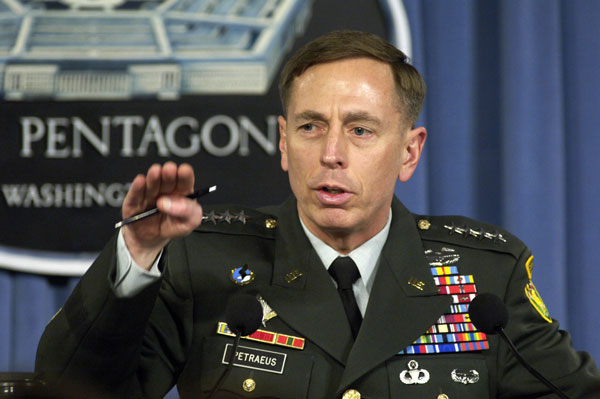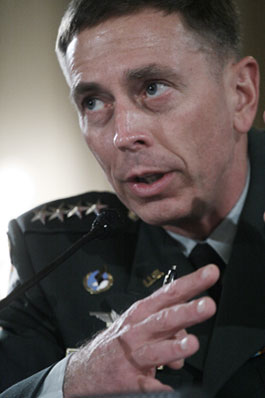King David
While commanding the 101st Airborne Division during the 2003 invasion of Iraq, David H. Petraeus famously mused to journalist Rick Atkinson, Tell me how
Jul 31, 20208.7K Shares116.7K Views
Gen. David H. Petraeus (www.dodmedia.osd.mil)
While commanding the 101st Airborne Division during the 2003 invasion of Iraq, David H. Petraeus famously musedto journalist Rick Atkinson, “Tell me how this ends.” Asked today by The Washington Independent how he would answer that if one of his own division commanders posed it, Petraeus replied by phone from Baghdad’s Camp Victory, ““
Image has not been found. URL: http://www.washingtonindependent.com/wp-content/uploads/2008/09/nationalsecurity1-150x150.jpgIllustration by: Matt Mahurin
But would that answer have satisfied Maj. Gen. Petraeus in 2003? “,” he said. “.” He mentioned Amb. Ryan Crocker’s comment to the Senate, that Iraq was “just plain hard,” adding, “.”
Petraeus is no stranger to either difficulty or realism. His obstacles have come from many places, and long before he took command in Iraq, his most daunting challenge yet. In the Army, Petraeus studied counterinsurgency (COIN) early in his career in the 1970s and 1980s, at a time when the Vietnam-wounded service wanted nothing to do with methods of warfareused to draw a civilian population’s political and personal allegiance away from a guerrilla force. “,” he said during an hour-long conversation. “.”
Indeed, Petraeus’s 1987 Princeton dissertation focused on how the military systematically stripped away its institutional knowledge of counterinsurgency in the wake of the Vietnam trauma. He did not realize that he would ultimately become the military’s most important advocate of counterinsurgency — a discipline that, despite the traumatic experience of the Iraq war, is on the rise, thanks to a new generation of defense theorist-practitioners. Many of them refer to Petraeus as “King David.”
Every army of liberation has a half-life after which it turns into an army of occupation…You can extend that half-life by being considerate of the population … But over time, again, you are not one of them.
It is clearly not a nickname he embraces. But he does view his time commanding Multinational Force-Iraq as a vindication of counterinsurgency principles. “.
Yet the future of counterinsurgency within the military is by no means certain. The service chiefs of the Army and Marine Corps — the two services charged with implementing counterinsurgency — are, at best, counterinsurgency skeptics. But Petraeus is more responsible than any other officer for embedding counterinsurgency in the architecture of the military.
After leaving his second Iraq tour in 2005 — he was a division commander during the 2003 invasion and then headed the troubled effort to train Iraqi security forces — Petraeus took the unusual step of leading the Combined Arms Center at Ft. Leavenworth, where the Army educates its mid-career officers. There, Petraeus started the Army’s first counterinsurgency course in at least a generation, and spearheaded the creation of a joint Army/Marine Corps counterinsurgency field manual, known as FM 3-24. It is known, to some, as King David’s Bible.
Petraeus declines to take credit. Instead, he emphasizes how far the military has come in a few short years toward preparing itself for counterinsurgency. he said, referring to the officers who contributed to the field manual.
“David Petraeus will go down in history as a great counterinsurgency theorist and practitioner,” said retiring Army Lt. Col. John Nagl, one of the counterinsurgency experts who helped write FM 3-24. “From his Princeton doctoral dissertation on counterinsurgency in Vietnam through three tours in Iraq — during the last of which he wrote the introduction for the first-ever translation in French of David Galula’s classic ‘Counterinsurgency Warfare: Theory and Practice’ after leading the writing team that produced the Army-Marine Corps counterinsurgency field manual — Gen. Petraeus has led the Army to rediscover ‘the graduate level of war.’”
Petraeus’ career has been meteoric. For the arguably-Pyrrhic accomplishment of reducing violence in Iraq to 2005 levels — which, during 2005, was considered unacceptable — Petraeus has not only become the most respected military officer since Colin L. Powell, but President George W. Bush has nominated him to helm U.S. Central Command, putting him in charge of all Middle East and South Asia military planning. As he is awaiting confirmation hearings, Petraeus would not discuss anything pertaining to his nomination.
By taking command in Iraq, Petraeus tacitly made Iraq as synonymous with his reputation as counterinsurgency is. Yet public — and military — exhaustion with the Iraq war risks tainting the entire discipline of counterinsurgency. That raises questions about whether the two can practically be disentangled — or whether failures in Iraq will come to be seen as failures of counterinsurgency, even if the nation’s most respected general symbolizes both.
“The American Army–especially at the small unit tactical level where platoons, companies, battalions, and brigades operate–has embraced, and not been resistant to, counterinsurgency in Iraq,” said Army Lt. Col. Gian Gentile, a counterinsurgency skeptic who commanded a combat battalion commander in west Baghdad in 2006 for his second Iraq tour. “The American Army has been conducting best practices in counterinsurgency operations in Iraq since as far back as the middle of 2004. What history shows is that there are limits to what even competent combat outfits conducting best practices of tactical methods and techniques can accomplish in complex counterinsurgencies that are embedded in larger civil wars.”
Nathaniel Fick, a Marine veteran of both Afghanistan and Iraq, largely agreed. “
Others have been harsher — and more focused on Petraeus himself. The anti-war American Conservative magazine called him a “Sycophant Savior” on its cover shortly after his September congressional testimony. “
Petraeus’s response has been to focus less on his critics than on his myriad challenges. In Iraq, even with a strategy centered on protecting civilians from extremist or militia threats, he realizes that a foreign military will never be embraced — a recognition highlighting one of the many complexities of counterinsurgency. “,” he said. ““
Following last month’s battle between the Iraqi security forces and Moqtada Sadr’s Mahdi Army militia in Basra, he said, he heard from a local Shiite official, “.” Sunnis, he said, have told him much the same, referencing the defeat of Saddam Hussein and then the American-led strikes against Al Qaeda in Iraq.
But much about both forces raises serious questions about both the course of the Iraq war and the potential for counterinsurgency to prove decisive in conflict.
Both the Mahdi Army and the broader Sadrist Current that it belongs to remain a potent, even dominant, forces in Shiite politics, even after the conflict with Maliki. And Petraeus’ approach to 2006′s split between Al Qaeda and the Sunni Iraqis was to stand up a corps of mostly-Sunni militiamen willing to stand against the terrorist force — but many among the now 90,000 militiamen resist the Shiite-led Iraqi government’s legitimacy.
Petraeus downplays the troubles with both. With Sadr, he reassures that “behind Maliki against the radical leader. When asked about reportsfrom The New York Times and McClatchy on April 28 that Shiite and Kurdish parliamentarians joined with a pro-Sadr protest in Sadr City, Petraeus first called those accounts “,” but then conceded, “.”
And with the so-called Sons of Iraq Sunni militiamen, he said they “.” Asked if there was a difference between the Sunnis rejecting Al Qaeda and them embracing the Shiite-led government, Petraeus answered, ““
His approach to both is textbook counterinsurgency: offer inducements to the Sunnis and the Shiites who can be reconciled to the U.S.-backed political process and confront those who don’t. While denouncing the Mahdi Army’s “thugs,” he repeatedly praised “and said the movement now led by Moqtada Sadr “.”
That, he said,
****It remains uncertain which endgame awaits Iraq, and Petraeus readily calls his security progress, “.”
But even with Iraq being potentially as traumatic for the U.S. military as Vietnam was, Petraeus doesn’t think it will repeat its post-Vietnam decision to wipe counterinsurgency from its institutional memory. The times, for one thing, don’t allow the military that luxury. “,” he said.
Like after Vietnam, there will be those who say “the best way to avoid doing this again is to not have the ability to do this again. But,” he concluded, “.”
*This is the fifth in a series: The Rise of the Counterinsurgents. *
Part One: The Colonels and ‘The Matrix’
Part Two: A Famous Enigma
Part Three: Petraeus’ Ascension
Part Four: The Insurgent as Counterinsurgent

Rhyley Carney
Reviewer
Latest Articles
Popular Articles

